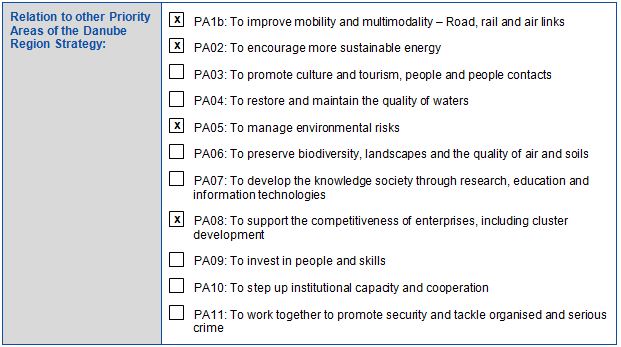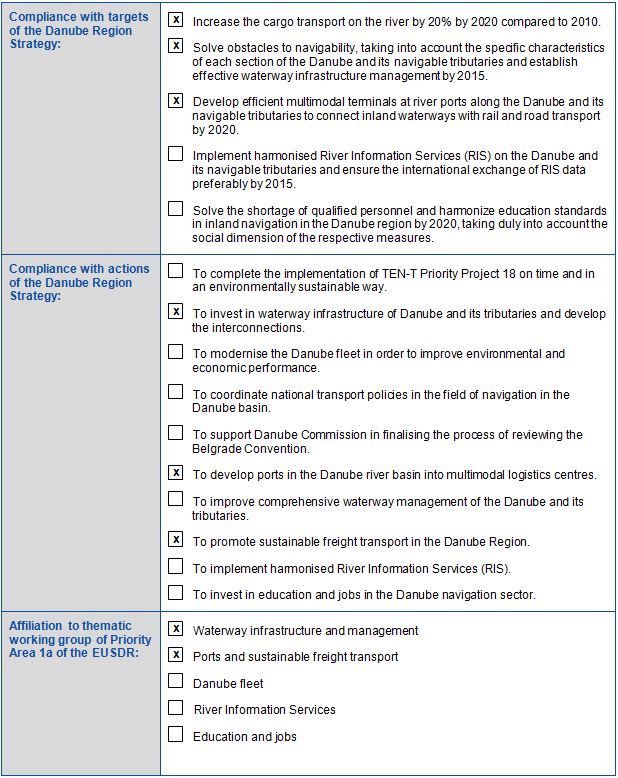BASIC PROJECT DATA – PROJECT IDEA
Project ID: PA1A002
NEED AND ADDED VALUE FOR THE DANUBE REGION STRATEGY
The aim of this project is the creation of a waterway to connect Bucharest, the capital of Romania, to the Danube river, hence “Danube-Bucharest Canal”. Completing the works which were started in 1986 and stopped in 1991 on the lower courses of the Argeş and Dâmboviţa rivers would be essentail to make use of such waterworks.
More specifically, they can be used to:
- Confine and harness the water discharge volumes of around 1,740 cubic meters/sec to the Grădinari section and of around 1,900 cubic meters/sec downstream of Budeşti;
- connect Bucharest with the Danube, namely with the Trans-European Transport Corridor VII, through a waterway having the transport capacity of up to 20 million tons/year on the Budeşti–Bucharest Port–1 Decembrie sector and 4 million tons/year on the Budeşti–Bucharest Port–Glina sector; the total length of the waterway is about 104 km (on both rivers);
- protect around 50,000 hectares of farmland and 11 localities from flooding (around 9,797 individual households);
- supply the necessary water for irrigating around 150,000 hectares of farmland and supply the drinking water for neighbouring localities;
- produce around 126 GWh/year of power in the water power plants located at the water junctions (locks) of the waterway;
- supply around 1,250 hectares for aquafarming;
- develop leisure and tourism in the riverine area.
The results would be favourable ecological influences, given that inland waterway transport is less polluting than other transport modes. Also, creating an important 3,000 hectares lake added to those around 1,000 hectares on the Dâmboviţa, in an area lacking precipitation, this can result in positive influences on the microclimate.
OBJECTIVE(S) OF THE PROJECT
The main goals pursued by the complex development of the Danube–Bucharest Canal system are:
- Connecting Bucharest with the Danube river by waterway, which would be an extremely profitable and eco-friendly alternative to rail and road transport;
- defending 11 localities and 50,000 hectares of farming land from floods;
- producing power, establishing the necessary conditions for leisure and tourism, providing favourable ecological influences and other similar elements;
- supplying the necessary water to irrigate over 150,000 hectares of land as well as providing drinking water for neighbouring localities and 1,250 hectares for aquafarming.
PLANNED PROJECT ACTIVITIES
The works for arranging the lower part of the Arges river entail the regularization of the river flow in order to allow the access of convoys made up of one barge (2,000 tons) and its related pusher (800 horse powers), as well as the confinement of the river with four successive canal locks which shall take over the 53 m difference level between the Argeş waters in the area of the Bucharest port and its junction with the Danube. The transport capacity of the Arges waterway, having in view the reference convoy and the sizes of the locks, would be up to 20 million tons/year. The length of waterway on Arges river is 73 km.
The waterworks for making the Dambovita river navigable entail the channelling, erection of dams and confinement of the river waters on the sector limited by the road bridge crossing the river in Glina and its junction with the Arges River in Budesti. The Damboviţa waterway and its related waterworks, including the locks from the water junctions at Tanganu and Cucuieti, were based on the reference convoy made up of a 2,000 tons barge and its related pusher (800 horse powers). The transport capacity of the Dâmboviţa waterway–Glina – Budeşti sector is four million tons/year. The length of the waterway on the Dambovita river is 31 km.
The waterway shall feature two ports in Bucharest (1 Decembrie and Glina) and at the junction of the Argeş river with the Danube river, there is the Olteniţa Port.
At the completion of the works, in the two ports of Bucharest, self-propelled ships that operate frequently on the European waterways shall have access, namely: the container ships having a capacity of 200 TEU, the ships for the transport of 600 cars, the Ro-Ro ships for 72 units, the passenger ships with a capacity of 150 passengers.
The Bucharest-1 Decembrie port shall have operational quays with a total length of 2,480 m and the total surface of the port platform shall have 336,000 square meters. Constructions include: a multipurpose building (for the river administration, the central dispatcher for the management of the navigation on the entire system, the management of the waters in terms of quality and quantity), a store house for the goods, running ways for the cranes and for installing the ports equipment, as well as the accessories for the berths operation.
The Bucharest-Glina port shall have operational quays with a total length of 785 m and the surface of the port platform shall have 140,000 square meters.
The Oltenita port (at the junction of the Argeş river with the Danube river), shall have operational quays with a total length of 1,080 m and the total surface of the port platform shall have 265,000 square meters. Constructions include a multipurpose building.
Within the feasibility study performed there were also included the railway and road links of the ports, the static and light signalling systems and the implementation of the river information services.
TRANSBOUNDARY IMPACT
On the Danube–Bucharest Canal goods would be transported by inland vessels flying different flags.
Connecting Bucharest with the Danube river by waterway would be an extremely profitable and eco-friendly alternative to rail and road transport.
PROJECT BENEFICIARIES / TARGET GROUPS
- Shipping companies
- Forwarders
- Port operators
- Agriculture and energy
STATUS AND TIMEFRAME
Start and end date of continuing works need to be determined.
NOTES
- Around 60% of the works were completed in the period 1986 – 1990.
- In 1991, the works were stopped.
- In 2009, the National Company “Administration of the Navigable Canals” SA awarded the contract for updating the feasibility study and the technical expertise of the already performed construction works. The value of the contract was EUR 1.8 million and the financing was provided from state budget.
- The technical – economical documentation of the project was approved by the Technical – Economical Committee of the Ministry of Transport and Infrastructure and by the Interministerial Committee in 2012. At present, the project needs to be approved by Government Decision.
- As of 2017, implementation is not planned in the near future. The project was supposed to be conducted from 2014 until 2020.
FINANCING
Total budget: 1,706,127,000 EUR
The project is planned to be implemented using state budget, co-financing through the Cohesion Fund and public-privat partnership money.
PROJECT TEAM
Project leader: Administration of Navigable Canals (ACN), Constanţa / Romania (website: www.acn.ro)
Address: Ecluzei Street no. 1, Agigea / Romania
There are no additional partners involved.
PROJECT ENVIRONMENT
STRATEGIC REFERENCE
- Navigation and Inland Waterway Action and Development in Europe (NAIADES) COM (2006) 6 final
- White Paper Roadmap to a Single European Transport Area – Towards a competitive and resource efficient transport system COM(2011) 144 final
RELEVANT LEGISLATION
- Government decision no. 487/2008 regarding the transmission of the investment the “Arrangement of the Arges river for flood protection, irrigation and other uses” and other public property assets form the administration of the Ministry of Environment and Sustainable Development – National Administration “Romanian Waters” to the administration of the Ministry of Transports through the National Company “Navigable Canals Administration” in order to achieve an inland waterway between Bucharest and Danube River
- Government Decision no. 599/2009 regarding the organisation of the National Company “Administration of Navigable Canals”
- All EU Directives related to environmental protection
OTHER
In 2011, the Bucharest–Danube Canal was included in the TEN-T Core Network by the European Commission.
EUSDR EMBEDDING
EUSDR COMPLIANCE
OTHER RELEVANT ISSUES
PROJECT REQUIREMEMENTS
Financing ensured for the project’s completion.
FOLLOW – UP PROJECT
Development of Ports of Bucharest and Oltenita.
META DATA
Data provided by: Cristina Cuc, Monica Patrichi (Ministry of Transport and Infrastructure, Romania) – 13.09.2011
Last updates by: Monica Patrichi (Ministry of Transport and Infrastructure, Romania) – 01.04.2013;
Adina Hilca, Silviu Udrea (Administration of the Navigable Canals SH) – 08.04.2013
Download pdf



